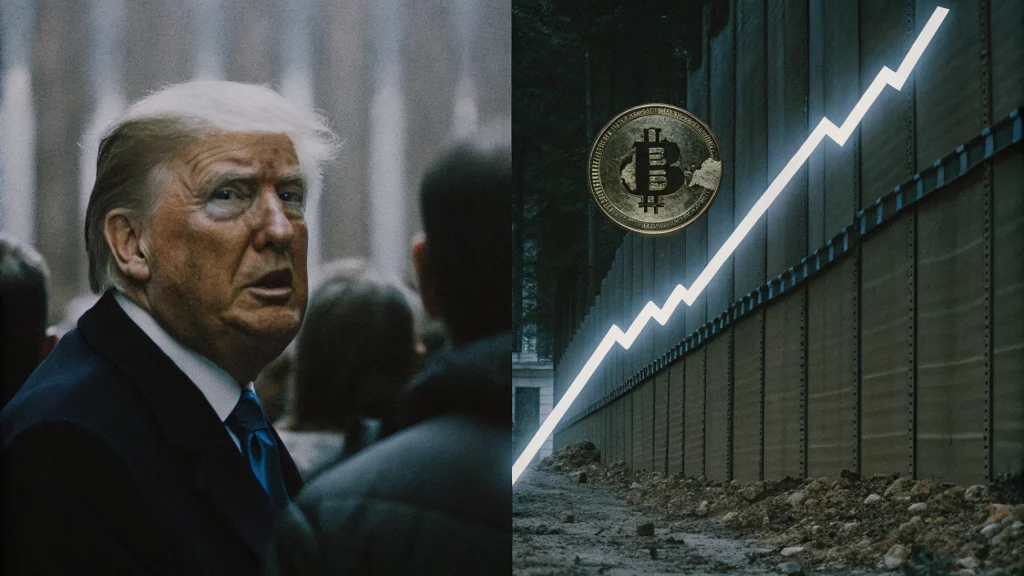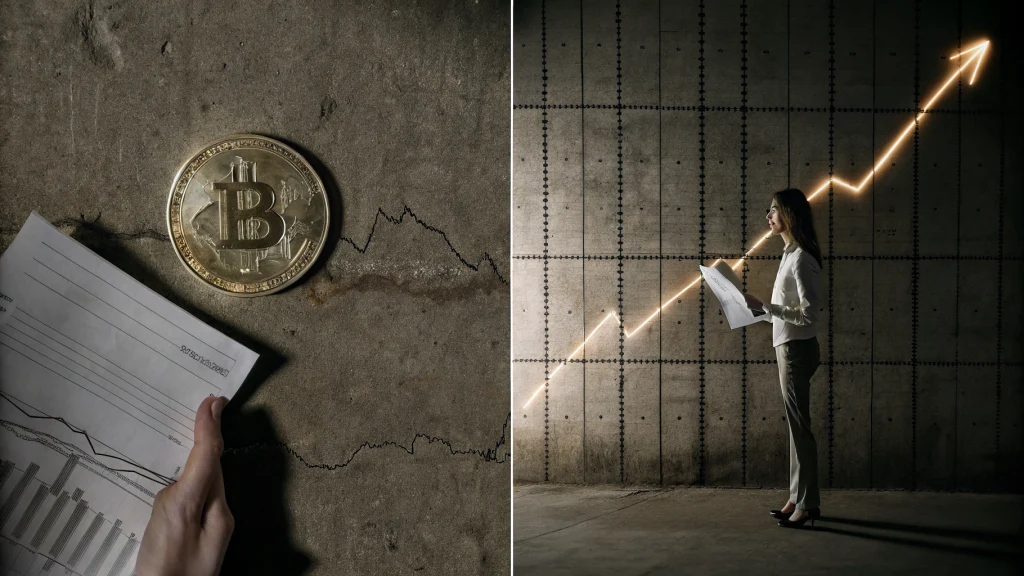Trade Wars Redux: Trump’s 2025 Tariffs and the Crypto Market Landscape (April 2025)

I. Introduction: A New Era of Tariffs and Digital Asset Uncertainty (April 2025)
April 2025 finds global markets grappling with a renewed and intensified wave of U.S. protectionism under the second Trump administration. Declaring April 2nd “Liberation Day,” President Trump unleashed a barrage of new tariffs, invoking the International Emergency Economic Powers Act (IEEPA) to impose broad duties on imports, significantly escalating trade tensions, particularly with China. This aggressive trade posture coincides with a cryptocurrency market that, while more mature than during Trump’s first term, remains inherently volatile and increasingly intertwined with traditional financial systems and macroeconomic sentiment. Bitcoin, having reached record highs near $109,000 earlier in the cycle, now trades around $70,000-$80,000, facing pressure from both macroeconomic headwinds and internal market dynamics like long-term holder movements.
This report analyzes the unfolding impact of the Trump administration’s current tariff regime, implemented in early 2025, on the cryptocurrency market. It examines the specific tariff measures, their direct consequences for the critical crypto mining hardware supply chain, the resulting market volatility and investor sentiment, and the ongoing debate about crypto’s role amidst heightened economic uncertainty. The analysis incorporates perspectives from key market observers and industry leaders navigating this complex environment. Furthermore, it provides essential context by briefly reviewing the tariff and crypto policy landscape during President Trump’s first term (2017-2021) and contrasting it with the approach of the intervening Biden administration (2021-2025).

The following sections will detail the sweeping 2025 tariff actions, assess their immediate effects on crypto mining economics, analyze the broader market reaction and the prevailing “risk-off” sentiment, synthesize current commentary from Key Opinion Leaders (KOLs), and then step back to compare the current environment with the preceding administrations before offering concluding thoughts on the path forward for crypto amidst this renewed trade conflict.
II. The 2025 Tariff Barrage: Unprecedented Measures Reshaping Global Trade
The Trump administration’s return to power in 2025 brought an immediate and forceful reshaping of U.S. trade policy, characterized by the rapid implementation of broad and targeted tariffs justified under national emergency powers. Citing large and persistent trade deficits as a threat to national security and the economy, President Trump utilized the International Emergency Economic Powers Act (IEEPA) as the primary legal basis for these actions.
Key Tariff Actions (January – April 2025):
- IEEPA Tariffs (February 2025): Invoking IEEPA, the administration imposed tariffs citing national security concerns related to border security and the fentanyl crisis. This included a 10% tariff on all imports from China (effective Feb 4), later increased to 20% (effective Mar 4), and 25% tariffs on Canada and Mexico (initially announced Feb 1, effective Mar 4 after a delay). The de minimis exemption (allowing duty-free import of shipments under $800) was also suspended for goods from China and Hong Kong, effective February 4 (later formally ended May 2).
- Steel and Aluminum Tariffs (March 2025): Building on first-term policies, 25% tariffs were imposed on all steel and aluminum imports effective March 12, eliminating previous exemptions and expanding the scope (e.g., aluminum tariffs extended to cans and canned beer on April 2). The administration mandated domestic “melted and poured” steel and “smelted and cast” aluminum to qualify for duty-free status.
- Automobile Tariffs (April 2025): Citing national security, a 25% tariff on imported automobiles and parts took effect April 3. While USMCA-compliant vehicles from Canada and Mexico received delays/exemptions after industry lobbying, non-compliant brands faced the tariff.
- “Liberation Day” Reciprocal Tariffs (April 2025): On April 2, a sweeping executive order established a baseline 10% “reciprocal tariff” on nearly all imports globally (effective April 5), with Canada and Mexico largely exempted. Furthermore, higher reciprocal tariffs (ranging from 11% to 50%) were imposed on 57 specific countries deemed to have nonreciprocal trade practices, effective April 9. China faced a 34% reciprocal rate under this order. Tariffs on the EU were set at 20%.
- Escalation with China (April 2025): Following China’s announcement of retaliatory 34% tariffs (effective April 10) , President Trump threatened an additional 50% tariff on Chinese imports on April 7, potentially bringing the total effective IEEPA-based tariff rate on Chinese goods to over 100% if implemented (effective April 9).
Economic Impact and Market Reaction:
These measures represent a dramatic increase in protectionism, pushing the U.S. trade-weighted average tariff rate from around 2% to an estimated 24% by April 2025, the highest in over a century. Initial estimates suggested the tariffs would raise nearly $2.9 trillion in revenue over a decade but reduce U.S. GDP by 0.7% and lower average after-tax income by 1.9% (over $1,900 per household in 2025) before accounting for retaliation. The rapid succession of announcements and short implementation timelines created significant market volatility and uncertainty. Stock markets experienced sharp declines, and concerns about a global economic slowdown intensified.

Table 1: Key Trump Administration Tariffs (Jan-Apr 2025)
| Tariff Action | Legal Basis | Target(s) | Rate(s) | Effective Date(s) | Key Notes |
|---|---|---|---|---|---|
| IEEPA Fentanyl/Border | IEEPA | China | 10% -> 20% | Feb 4 -> Mar 4 | De minimis suspended |
| IEEPA Fentanyl/Border | IEEPA | Canada, Mexico | 25% | Mar 4 (after delay) | |
| Steel & Aluminum | Sec. 232 | Global | 25% | Mar 12 (expanded Apr 2) | Exemptions removed, scope expanded |
| Autos & Parts | Sec. 232 | Global | 25% | Apr 3 | USMCA compliance affects North America |
| “Liberation Day” Universal Tariff | IEEPA | Global (excl. Canada/Mexico mostly) | 10% | Apr 5 | Baseline reciprocal tariff |
| “Liberation Day” Reciprocal | IEEPA | 57 specific countries (e.g., China, EU) | 11%-50% (China 34%, EU 20%) | Apr 9 | Replaces 10% baseline for these countries |
| China Retaliation Response | IEEPA | China | Additional 50% (threatened) | Apr 9 (if implemented) | Response to China’s 34% retaliation |
| De Minimis End (Formal) | EO | China, Hong Kong, Macau | N/A (Removes $800 duty-free threshold) | May 2 (intended) |
Sources:
This aggressive tariff strategy sets the stage for significant disruption across numerous sectors, including those vital to the cryptocurrency ecosystem.
III. Hardware Under Pressure: The 2025 Tariff Impact on Crypto Mining
The sweeping tariffs enacted in early 2025 pose a direct and significant threat to the U.S. cryptocurrency mining industry, primarily by increasing the cost and potentially disrupting the supply of essential mining hardware. Application-Specific Integrated Circuits (ASICs), the specialized and highly efficient chips crucial for Bitcoin mining, are a key area of concern.
Rising Costs and Supply Chain Woes:
The U.S. remains heavily reliant on imported electronic components and machinery, particularly from Asia. China is a dominant manufacturer of ASIC mining hardware. The multi-layered tariffs imposed in 2025 – including the initial 20% IEEPA tariff on Chinese goods, the subsequent 34% reciprocal tariff, and the threatened additional 50% levy – dramatically escalate the cost of importing this equipment. While semiconductors themselves were initially reported as exempt from the April 2nd tariffs, this exemption’s durability is uncertain, and related hardware like high-performance computing systems and servers are affected. Furthermore, tariffs on imports from other manufacturing hubs like Malaysia (36%) and Thailand (24%) also impact miners sourcing equipment from these regions, potentially as alternatives to China. This creates significant pricing pressure and logistical challenges.
Consequences for U.S. Miners:
- Increased Capital Expenditures (CapEx): Higher hardware costs directly inflate the initial investment required to set up or expand mining operations, squeezing profit margins and extending ROI timelines.
- Operational Viability: For miners operating on thin margins, particularly if cryptocurrency prices face downward pressure, the added tariff burden could make operations unprofitable, potentially forcing shutdowns or relocation.
- Supply Disruptions: The rapid implementation and uncertainty surrounding tariffs create logistical nightmares. Miners have reportedly rushed to import equipment ahead of deadlines, fearing delays and shortages. This disrupts planning and potentially hinders access to the latest, most efficient generation of mining rigs necessary to remain competitive.
- Shift in Global Hash Rate: Increased costs for U.S. miners could slow the growth of the domestic hash rate and make other regions with lower hardware costs more attractive, potentially shifting the global distribution of mining power. Some U.S. miners might even consider relocating operations outside the country.
Industry Responses:
Hardware manufacturers may be forced to accelerate plans to diversify manufacturing away from heavily tariffed regions or potentially establish more robust assembly operations within the U.S. to mitigate duties, although core component sourcing often remains international. The pressure could also favor larger, well-capitalized mining firms better equipped to absorb costs or secure hardware supply, potentially leading to further industry consolidation. The impact on crypto mining costs is a critical factor shaping the industry’s landscape in 2025.
IV. Market Tremors: Crypto Reacts to Renewed Trade Tensions (April 2025)
The aggressive rollout of tariffs in early 2025 has injected significant volatility and uncertainty into global financial markets, and the cryptocurrency space has not been immune. As of April 2025, crypto assets are exhibiting familiar patterns of correlation with broader risk assets, reacting negatively to escalating trade tensions.

Correlation and Risk-Off Sentiment:
Historically, and continuing into 2025, Bitcoin and other major cryptocurrencies have often traded in line with tech stocks and other risk-sensitive assets. Tariff announcements and threats of escalation have frequently triggered sell-offs in equity markets, with crypto markets often following suit. The heightened uncertainty surrounding potential economic slowdowns, inflation impacts, and retaliatory measures appears to be driving investors towards perceived safer assets, leading to outflows from riskier categories like crypto. The period saw significant liquidations in crypto derivatives markets, highlighting the impact of this volatility. Bitcoin’s price, for instance, saw downward pressure coinciding with tariff escalations, dropping from levels above $80,000 towards the mid-$70,000s before attempting stabilization.
Indirect Impacts Magnified:
While tariffs don’t directly tax cryptocurrencies, the indirect effects are substantial :
- Economic Slowdown: Fears that tariffs could trigger a recession weigh heavily on crypto. In an economic downturn, investors typically reduce exposure to speculative assets, and individuals might liquidate holdings to cover expenses.
- Inflation Concerns: Tariffs can contribute to inflation by raising import costs. While some argue this could eventually bolster Bitcoin’s “digital gold” narrative as an inflation hedge , the immediate market reaction often reflects broader economic anxiety rather than a flight to crypto as a primary inflation hedge.
- Mining Profitability: As discussed in the hardware impact section, pressure on miner profitability due to increased hardware costs could lead to miners selling holdings to cover operational expenses, adding to selling pressure in the market.
Market Sentiment and Uncertainty:
The sheer pace and scope of the 2025 tariffs have created a climate of pervasive uncertainty. This makes long-term investment planning difficult and favors short-term, reactive trading. The crypto market, still influenced by retail sentiment and increasingly integrated with traditional finance, reflects this nervousness. While some long-term holders might see opportunity , analysis of on-chain data suggests potential caution, with movements of older coins possibly signaling profit-taking or risk reduction by long-term investors. The overall market volatility underscores crypto’s sensitivity to these major macroeconomic shifts.
V. Voices from the Street & The Cryptoverse: KOL Perspectives on the 2025 Tariffs
(Wall Street Style Section): The re-emergence of aggressive U.S. tariff policies under President Trump in 2025 has reignited debate among Key Opinion Leaders (KOLs), analysts, and industry executives regarding the implications for the cryptocurrency market. Commentary reflects a mix of concern over immediate economic impacts and speculation about longer-term, potentially counterintuitive, consequences.

Synthesizing Current Views (April 2025):
- Focus on Macro Risk & Market Correlation: Many prominent voices emphasize the negative short-term impact stemming from crypto’s behavior as a risk asset. Economist Peter Schiff warns that markets underestimate recession risks exacerbated by tariffs and dismisses Bitcoin as a likely solution to the market crisis. Chart analyst Peter Brandt identified $54,000 as a potential significant retracement level for Bitcoin if economic pressures persist. Analysts note Bitcoin’s slide in correlation with broader market declines driven by tariff fears, highlighting the dominance of “risk-off” sentiment. BlackRock CEO Larry Fink’s earlier warnings about U.S. debt and the potential rise of digital assets like Bitcoin gain new relevance in the context of tariff-induced fiscal instability.
- Mining Industry Headwinds: Concerns about the direct impact on the crypto mining sector are prevalent. Analysts highlight the U.S. industry’s reliance on imported hardware, particularly ASICs from China, and the severe cost pressures imposed by the cumulative 2025 tariffs. Matt Pearl from CSIS reiterated that levies on China disrupt supply chains and raise operational costs for U.S. miners. The potential for supply delays and the rush to import hardware before tariffs take full effect underscore the disruption.
- Potential for Capital Flight & Long-Term Bull Case: Some influential commentators speculate that the trade war, particularly with China, could drive capital towards Bitcoin. Arthur Hayes (BitMEX co-founder) suggests that a potential devaluation of the Chinese Yuan (CNY) to counter tariffs could trigger capital flight into Bitcoin, reprising a narrative seen in previous years. Bybit CEO Ben Zhou echoed this, noting historical correlation between CNY drops and BTC inflows. Becca Bratcher argues that Trump’s tariffs, by potentially undermining confidence in the dollar and highlighting fiscal risks, strengthen the long-term case for Bitcoin as a necessary reserve asset. Bitwise CEO Hunter Horsley noted Bitcoin’s origins in financial crisis, suggesting its role as a hedge might be tested again.
- Skepticism and Counterarguments: The capital flight thesis faces skepticism. Critics point to China’s strict crypto bans and capital controls, questioning the feasibility of large-scale conversion from CNY to BTC. Some suggest capital might flow into stablecoins like USDT first, rather than directly into Bitcoin. Peter Schiff remains a vocal skeptic, highlighting the poor performance of the U.S. Strategic Bitcoin Reserve since its inception.
- Broader Tech Impact: Beyond crypto specifics, the tariffs’ impact on the broader tech supply chain, including semiconductors (despite temporary exemptions) and AI hardware, is noted as a source of concern and potential cost increases across the electronics industry.
From X:
- @Cryptic_Web3 (X post) reported that Trump’s tariffs sent Bitcoin below $100,000, with over $8 billion in liquidations, but also noted some analysts see this as a “buy-the-dip” opportunity.
- @tikooww (X post) emphasized that even decentralized crypto is not immune, citing a 14% Bitcoin drop following tariff announcements.
- @DeFiMidas (X post) warned of increased volatility due to tariff uncertainty, leading to cautious trading behaviors.
- @CryptoExpert101 (X post) stated Trump has been a net negative for crypto, predicting higher prices due to tariffs and a potential recession.
- @Ranger8125 (X post) expressed a bearish outlook, comparing current tariffs to those during the Great Depression.
- @AltaEnigma (X post) highlighted unexpected 100% crypto profit tariffs, suggesting political theater and potential market triggers.
The current discourse reflects the tension between immediate, observable negative market reactions and potential longer-term structural shifts that could favor decentralized assets. While the “risk-off” correlation currently dominates price action , the narrative around Bitcoin as a potential hedge against geopolitical and fiscal instability persists, fueled by the administration’s aggressive policies.
Table 2: Key Opinion Leader (KOL) Stances on 2025 Trump Tariffs and Crypto (as of April 2025)
| KOL Name/Affiliation | Key Stance/Argument | Supporting Snippet(s) |
|---|---|---|
| Peter Schiff (Economist) | Tariffs increase recession risk; markets underestimate danger; Bitcoin unlikely to solve crisis; criticizes US Bitcoin reserve performance. | |
| Peter Brandt (Chart Analyst) | Identified $54k as key BTC retracement level; downside risk persists if trade war/economic pressure continues. | |
| Larry Fink (BlackRock CEO) | Earlier warnings about US debt/dollar risk vs. digital assets gain relevance due to tariff instability (cited by others). | |
| Matt Pearl (CSIS) | Tariffs on China disrupt supply chains and increase operational costs for US crypto miners. | |
| Arthur Hayes (BitMEX Co-Founder) | Potential CNY devaluation due to tariffs could drive Chinese capital flight into Bitcoin, similar to past instances. | |
| Ben Zhou (Bybit CEO) | Supports Hayes’ view: Historically, CNY drops correlate with Chinese capital flowing into BTC. | |
| Becca Bratcher (TheStreet) | Tariffs add fiscal pressure, strengthening Fink’s warning & the case for Bitcoin as a necessary reserve asset vs. dollar instability. | |
| Hunter Horsley (Bitwise CEO) | Notes Bitcoin’s crisis origins; suggests its role as a hedge may be tested again by current turmoil. | |
| Crypto Commentators (General) | Debate feasibility of China capital flight via BTC due to bans/controls; some suggest flow into stablecoins first. | |
| Analysts (General) | Note crypto’s negative correlation with risk assets during tariff sell-offs; highlight mining cost pressures; discuss broader tech supply chain impact. |
VI. A Look Back: Contrasting Administrations on Tariffs and Crypto (2017-2025)
Understanding the current interplay between tariffs and crypto benefits from examining the approaches of the preceding administrations.
First Trump Administration (2017-2021): Tariffs Emerge, Crypto Nascent
President Trump’s first term saw the initial imposition of significant tariffs, primarily targeting China under Section 301 and global steel/aluminum under Section 232, citing trade imbalances and unfair practices. These tariffs, rolled out in phases from 2018, increased costs for various goods, including electronic components vital for crypto mining. A key event was the 2018 USTR reclassification of mining hardware, subjecting it to higher base rates plus the Section 301 tariffs, significantly impacting U.S. miner costs. During this period, the crypto market was less mature, experiencing the 2017 ICO boom followed by a “crypto winter.” While tariffs added to market uncertainty and mining costs, crypto’s price action was often dominated by internal cycles and its correlation with risk assets during tariff-related sell-offs. The “digital gold” hedge narrative existed but wasn’t strongly reflected in market behavior; crypto often fell alongside stocks on negative trade news. Regulatory clarity was minimal, with focus largely on ICOs.
Biden Administration (2021-2025): Strategic Tariffs, Regulatory Scrutiny
The Biden administration largely maintained the existing Trump-era tariffs on China while conducting a lengthy review. Rather than broad new tariffs, Biden focused on strategic increases, particularly targeting sectors related to national security and domestic initiatives like green energy and semiconductors (e.g., EVs, batteries, solar cells, chips). This approach aimed to protect specific U.S. industries and investments (like those funded by the CHIPS Act and IRA) from perceived unfair Chinese competition and overcapacity, while emphasizing cooperation with allies. Biden officials framed this as a targeted, strategic approach distinct from Trump’s broader measures.
On cryptocurrency regulation, the Biden era was generally perceived by the industry as adopting a stricter stance, often characterized as “regulation by enforcement”. Agencies like the SEC pursued enforcement actions against crypto firms, and initiatives like SEC Staff Accounting Bulletin 121 (SAB 121) created hurdles for traditional institutions looking to custody crypto assets. While aiming for investor protection, this approach drew criticism for lacking clear, proactive regulatory frameworks. There was also exploration of a Central Bank Digital Currency (CBDC), a concept the subsequent Trump administration explicitly prohibited.
Second Trump Administration (2025-Present): Aggressive Tariffs, Regulatory Shift?
The current administration has returned with a much more aggressive and broader tariff strategy than its first term, using IEEPA powers extensively and rapidly escalating duties globally, especially against China. The economic justification centers on trade deficits and reciprocity. Concurrently, there’s been a signaled shift towards a more crypto-friendly regulatory environment. Key actions include an executive order promoting digital asset innovation, rescinding prior frameworks, establishing a new working group, appointing perceived crypto-friendly advisors and regulators, and explicitly prohibiting a U.S. CBDC. The SEC has also notably dropped some investigations and charges against crypto firms and signaled a potential shift away from classifying memecoins as securities. The repeal of SAB 121 removed a significant barrier for institutional crypto custody. This contrasts sharply with the perceived regulatory posture of the Biden years, aiming to foster growth while still pursuing some enforcement (e.g., OKX plea deal).
In essence, while both Trump administrations utilized tariffs aggressively against China, the 2025 version is broader and more rapid. The Biden administration maintained existing tariffs but focused new actions strategically, while taking a more cautious/skeptical regulatory approach to crypto. The current Trump administration combines its intensified tariff policy with a seemingly more accommodative stance towards the crypto industry’s development.
VII. Conclusion: Navigating the Storm (April 2025)
As of April 2025, the cryptocurrency market finds itself navigating the turbulent waters stirred by the second Trump administration’s aggressive tariff policies. The imposition of broad, multi-layered tariffs under IEEPA, particularly the escalating conflict with China, has injected significant uncertainty and volatility into global markets, with crypto assets feeling the impact.
The direct consequences for the U.S. crypto mining industry are stark, facing substantially higher costs for essential imported hardware, potential supply chain disruptions, and threats to profitability and competitiveness. This pressure could reshape the domestic mining landscape and influence the global distribution of hash power.
Broader market sentiment remains cautious, with cryptocurrencies largely trading as risk assets, sensitive to macroeconomic fears stoked by the trade war. While long-term narratives about Bitcoin as a potential hedge against geopolitical instability or currency devaluation persist and are debated by KOLs , the immediate price action reflects prevailing risk aversion.
Contrasting with the more targeted tariff approach and stricter crypto regulatory environment of the Biden administration , the current administration combines its sweeping protectionist measures with signals of a more favorable regulatory climate for digital assets. This creates a complex dynamic: macroeconomic headwinds generated by tariffs potentially depress prices in the short term, while a potentially more permissive regulatory environment could foster longer-term industry growth.
The situation remains highly fluid. The ultimate economic impact of the tariffs, the extent of foreign retaliation, and the durability of the administration’s crypto policies are uncertain. For participants in the cryptocurrency market, vigilance, adaptability, and a keen eye on the evolving interplay between trade policy, macroeconomic conditions, and regulatory developments will be crucial for navigating the challenging months ahead.
Citations
- President Trump Announces 10 Percent Global Tariff, 11 Percent to 50 Percent Reciprocal Tariffs
- Tariffs in the second Trump administration
- How Might New Tariffs Affect Bitcoin?
- Immediate Impacts, Risks, and Uncertain Future of President Trump’s Unprecedented Worldwide Tariffs
- US Crypto Mining in Crisis? How Trump’s Liberation Day Tariffs Could Shake the Industry
- Trump’s Crypto Tax Plan: Which Coins Will Benefit Most?
- Tariffs impact on markets 2025: Crypto and Gold outlook
- Mining Hardware Crunch: Donald Trump’s Tariffs Force Miners to Accelerate Imports
- Navigating Electronic Component Tariffs in 2025

